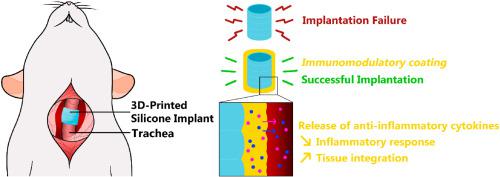Biomaterials ( IF 12.8 ) Pub Date : 2020-11-24 , DOI: 10.1016/j.biomaterials.2020.120549 J. Barthes , P. Lagarrigue , V. Riabov , G. Lutzweiler , J. Kirsch , C. Muller , E.-J. Courtial , C. Marquette , F. Projetti , J. Kzhyskowska , P. Lavalle , N.E. Vrana , A. Dupret-Bories

|
The recent advances in 3D-printed silicone (PDMS: polydimethylsiloxane) implants present prospects for personalized implants with highly accurate anatomical conformity. However, a potential adverse effect, such as granuloma formation due to immune reactions, still exists. One potential way to overcome this problem is to control the implant/host interface using immunomodulatory coatings. In this study, a new cytokine cocktail composed of interleukin-10 and prostaglandin-E2 was designed to decrease adverse immune reactions and promote tissue integration by fixing macrophages into M2 pro-healing phenotype for an extended period of time. In vitro, the cytokine cocktail maintained low levels of pro-inflammatory cytokine (TNF-α and IL-6) secretions and induced the secretion of IL-10 and the upregulation of multifunctional scavenging and sorting receptor stabilin-1, expressed by M2 macrophages. This cocktail was then loaded in a gelatine-based hydrogel to develop an immunomodulatory material that could be used as a coating for medical devices. The efficacy of this coating was demonstrated in an in vivo rat model during the reconstruction of a tracheal defect by 3D-printed silicone implants. The coating was stable on the silicone implants for over 2 weeks, and the controlled release of the cocktail components was achieved for at least 14 days. In vivo, only 33% of the animals with bare silicone implants survived, whereas 100% of the animals survived with the implant equipped with the immunomodulatory hydrogel. The presence of the hydrogel and the cytokine cocktail diminished the thickness of the inflammatory tissue, the intensity of both acute and chronic inflammation, the overall fibroblastic reaction, the presence of oedema and the formation of fibrinoid (assessed by histology) and led to a 100% survival rate. At the systemic level, the presence of immunomodulatory hydrogels significantly decreased pro-inflammatory cytokines such as TNF-α, IFN-γ, CXCL1 and MCP-1 levels at day 7 and significantly decreased IL-1α, IL-1β, CXCL1 and MCP-1 levels at day 21. The ability of this new immunomodulatory hydrogel to control the level of inflammation once applied to a 3D-printed silicone implant has been demonstrated. Such thin coatings can be applied to any implants or scaffolds used in tissue engineering to diminish the initial immune response, improve the integration and functionality of these materials and decrease potential complications related to their presence.
中文翻译:

具有免疫调节水凝胶的3D打印有机硅植入物的生物功能化,用于控制先天免疫反应:气管缺损修复的体内模型
3D打印有机硅(PDMS:聚二甲基硅氧烷)植入物的最新进展为具有高度精确的解剖结构一致性的个性化植入物提供了前景。但是,仍然存在潜在的不利影响,例如由于免疫反应而形成的肉芽肿。解决该问题的一种潜在方法是使用免疫调节涂层控制植入物/宿主界面。在这项研究中,设计了一种新的由白介素10和前列腺素E2组成的细胞因子混合物,以通过将巨噬细胞长期固定在M2修复表型上来减少不良免疫反应并促进组织整合。体外,细胞因子混合物维持低水平的促炎细胞因子(TNF-α和IL-6)分泌,并诱导IL-10的分泌以及多功能清除和分选受体Staabilin-1的上调,M2巨噬细胞表达了这种作用。然后,将这种混合物装载在基于明胶的水凝胶中,以开发出可以用作医疗设备涂层的免疫调节材料。在通过3D打印的有机硅植入物重建气管缺损的体内大鼠模型中证明了这种涂层的功效。涂层在硅氧烷植入物上稳定超过2周,并且鸡尾酒成分的控释达到至少14天。体内,只有33%的带有裸露硅树脂植入物的动物存活下来,而100%的动物在装有免疫调节水凝胶的植入物下得以存活。水凝胶和细胞因子混合物的存在减少了炎性组织的厚度,急性和慢性炎症的强度,整体成纤维细胞反应,水肿的存在和纤维蛋白样物质的形成(通过组织学评估),并导致了100 % 存活率。在全身水平,免疫调节水凝胶的存在在第7天显着降低了促炎细胞因子,如TNF-α,IFN-γ,CXCL1和MCP-1的水平,并显着降低了IL-1α,IL-1β,CXCL1和MCP-第21天为1级。这种新型免疫调节水凝胶一旦应用于3D打印的有机硅植入物,就能控制炎症水平。此类薄涂层可以应用于组织工程中使用的任何植入物或支架,以减少初始免疫反应,改善这些材料的整合和功能并减少与其存在相关的潜在并发症。











































 京公网安备 11010802027423号
京公网安备 11010802027423号